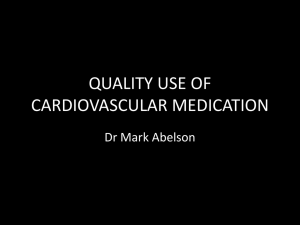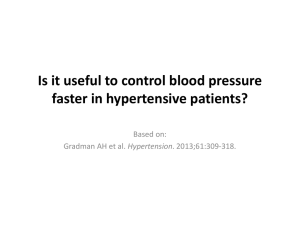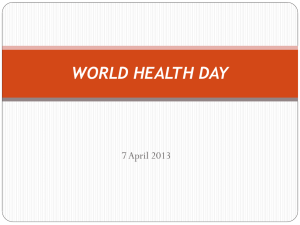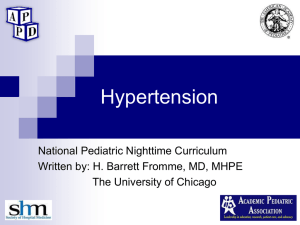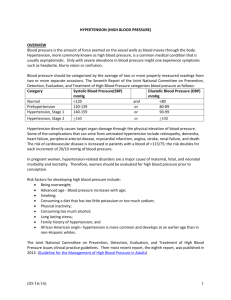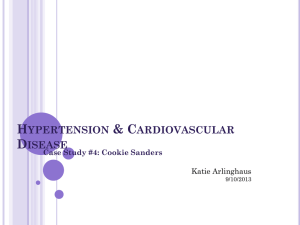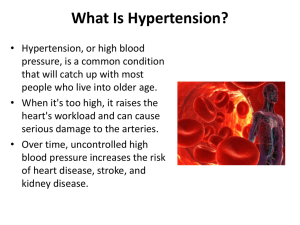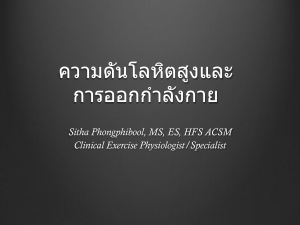article format LaPonza - Cal State LA
advertisement
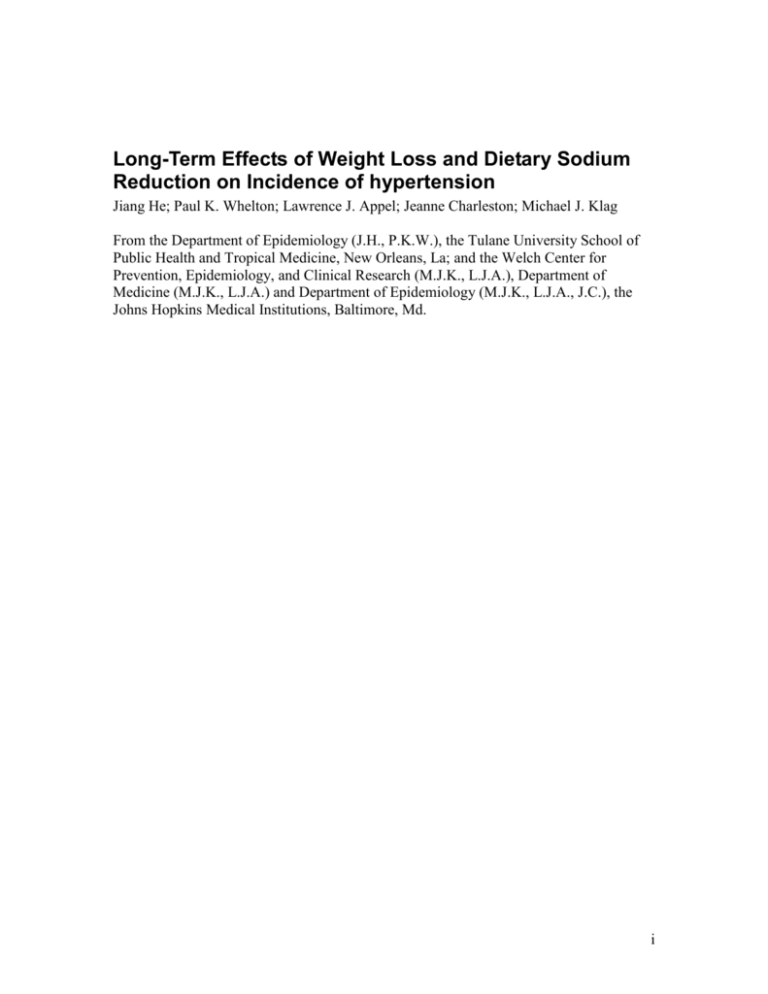
Long-Term Effects of Weight Loss and Dietary Sodium Reduction on Incidence of hypertension Jiang He; Paul K. Whelton; Lawrence J. Appel; Jeanne Charleston; Michael J. Klag From the Department of Epidemiology (J.H., P.K.W.), the Tulane University School of Public Health and Tropical Medicine, New Orleans, La; and the Welch Center for Prevention, Epidemiology, and Clinical Research (M.J.K., L.J.A.), Department of Medicine (M.J.K., L.J.A.) and Department of Epidemiology (M.J.K., L.J.A., J.C.), the Johns Hopkins Medical Institutions, Baltimore, Md. i Table Of Contents Long-Term Effects of Weight Loss and Dietary Sodium Reduction on Incidence of hypertension ......................................................................................................................... i Abstract ............................................................................................................................... 1 Introduction ......................................................................................................................... 2 Methods............................................................................................................................... 2 Study Participants ........................................................................................................... 2 Trial Conduct .................................................................................................................. 3 Post-trial Follow-Up ....................................................................................................... 3 Statistical Analysis .......................................................................................................... 4 Results ................................................................................................................................. 4 Post-trial follow-up Results ............................................................................................ 6 Discussion ........................................................................................................................... 7 Acknowledgments............................................................................................................... 9 References ........................................................................................................................... 9 ii Abstract Abstract—To examine the long-term effects of weight loss and dietary sodium reduction on the incidence of hypertension, we studied 181 men and women who participated in the Trials of Hypertension Prevention, phase 1, in Baltimore, Md. At baseline (1987 to 1988), subjects were 30 to 54 years old and had a diastolic blood pressure (BP) of 80 to 89 mm Hg and systolic BP <160 mm Hg. They were randomly assigned to one of two 18-month lifestyle modification interventions aimed at either weight loss or dietary sodium reduction or to a usual care control group. At the post-trial follow-up, from 1994 to 1995, blood pressure was measured by a group of blind observers. They used a random-zero sphygmomanometer. Incident hypertension was defined as systolic BP 160 mm Hg and/or diastolic BP 90 mm Hg and/or treatment with antihypertensive medication during follow-up. Body weight and urinary sodium were not significantly different among the groups at the post-trial follow-up. After 7 years of follow-up, the incidence of hypertension was 18.9% in the weight loss group and 40.5% in its control group and 22.4% in the sodium reduction group and 32.9% in its control group. In logistic regression analysis adjusted for baseline age, gender, race, physical activity, alcohol consumption, education, body weight, systolic BP, and urinary sodium excretion, the odds of hypertension was reduced by 77% (odds ratio 0.23; 95% confidence interval 0.07 to 0.76; P=0.02) in the weight loss group and by 35% (odds ratio 0.65; 95% confidence interval 0.25 to 1.69; P=0.37) in the sodium reduction group compared with their control groups. These results indicate that lifestyle modification such as weight loss may be effective in long-term primary prevention of hypertension. Key Words: diet, sodium-restricted • blood pressure • hypertension, incidence • weight loss 1 Introduction Hypertension is an important worldwide public health challenge because of its high prevalence and the concomitant increase in risk of cardiovascular and renal disease. For example, 50 million adult residents in the United States have hypertension, defined as having a systolic blood pressure (SBP) 140 mm Hg and/or diastolic blood pressure (DBP) 90 mm Hg and/or taking antihypertensive medications. Prospective studies have demonstrated a positive, continuous, and independent association between higher levels of BP and the risk of coronary heart disease, stroke, congestive heart failure, end-stage renal disease, and peripheral vascular disease. The benefits of lowering BP in reducing the risk of coronary heart disease and stroke have been documented in anti–hypertensive drug treatment trials. However, treatment of hypertension represents only a partial response to the overall burden of BP-related cardiovascular disease in the general population. To accomplish the broad goal of eliminating all BP-related diseases in the community, detection and treatment of hypertension must be complemented by strategies to prevent hypertension. Evidence from observational epidemiological studies has indicated that being overweight and having high salt intake are important risk factors for hypertension. Clinical trials have indicated that weight loss and sodium reduction lower BP in hypertensive patients as well as in normo tensive patients. However, the long-term effects of these interventions on the risk of hypertension are less well established. The purpose of the present study was to examine the effects of an 18-month lifestyle modification intervention aimed at either weight loss or dietary sodium reduction on the incidence of hypertension during 6 to 8 years of follow-up in a cohort of 181 men and women with high normal BP. Methods Study Participants The Trials of Hypertension Prevention, phase 1 (TOHP-1), was a national, multi-center, randomized controlled trial. It was designed to test the short-term feasibility and efficacy of lifestyle (weight loss, sodium reduction, and stress management) and nutrition supplement (calcium, magnesium, fish oil, and potassium) interventions aimed at lowering blood pressure in those whose DBP was initially in the high normal range (80 to 89 mm Hg). At the Johns Hopkins clinical center, 289 study participants were randomized into the trial: 60 to the weight loss intervention, 66 to the sodium reduction intervention, 82 to corresponding control groups for weight loss and/or sodium reduction, and 81 to the nutrition supplement intervention and control groups. Participants in the 2 lifestyle modification usual care control group could serve as a control for both the weight loss, if overweight, and/or sodium reduction intervention groups. Thus 49 of the 82 participants served as control subjects for the weight loss intervention and all 82 served as control subjects for the sodium reduction group. The principal eligibility criteria for participation in TOHP-1 included age between 30 and 54 years and an average DBP between 80 to 89 mm Hg and SBP <160 mm Hg. The principal exclusion criteria were evidence of hypertension or other cardiovascular disease, extreme obesity (body mass index [BMI] 36.1 kg/m2) or the use of heavy alcohol (21 drinks/wk). Those eligible for inclusion were further classified into high-weight (BMI of 26.1 to 36.1 for men and 24.3 to 36.1 for women) and low-weight strata (BMI <26.1 for men and <24.3 for women) before randomization. Trial Conduct Nutritionists and experienced counselors delivered the weight loss and sodium reduction interventions. They consisted primarily of group educational sessions, supplemented by individual counseling. The group sessions were attended by 11 to 12 participants and lasted for 90 minutes on each occasion. They were conducted on a weekly schedule for the first 14 and 10 weeks in weight loss and sodium reduction intervention groups, respectively. Subsequently, the meetings were held on a semimonthly and later a monthly frequency throughout the 18-month period of intervention. The weight loss and sodium reduction interventions focused on shopping, cooking, and food selection behaviors aimed at reducing the intake of calories and sodium, respectively. The weight loss intervention also encompassed a strategy to achieve a moderate increase in caloric expenditure, primarily by walking at a brisk pace for 45 minutes, 4 to 5 times per week. Baseline and follow-up data at 3, 6, 12, and 18 months were collected by specially trained, experienced observers who were blinded to the participants’ treatment assignment, using standardized methods and a stringent level of quality control. All data collectors passed an initial series of certification examinations as well as periodic recertification evaluations. BP measurements were obtained with the use of the Hawksley random-zero modification of the standard mercury sphygmomanometer. BP was measured after the individual had been seated quietly for 5 minutes. The subject was instructed not to eat or smoke for at least 30 minutes before their BP measurements. The first and fifth korotkoff sounds were recorded as SBP and DBP, respectively. Three BP measurements were recorded at each of 3 visits at the baseline and 12- and 18-month evaluations. Body weight and height were measured with the use of standard protocols. Two 24-hour urine specimens were collected at the baseline and 18-month follow-up visits for estimation of sodium and cretonne excretion. Post-trial Follow-Up At the Johns Hopkins clinical center, a post-trial follow-up examination was conducted between November 1994 and September 1995. Medical history, especially personal history of hypertension and use of antihypertensive medication, was evaluated by questionnaire. Trained observers who were blinded to treatment assignment and who used the same method as for the baseline visits obtained three BP measurements. Body 3 weight and height were also measured at the post-trial follow-up visit. A single 24-hour urinary specimen was collected to assess sodium and cretonne excretion. Hypertension at follow-up was defined as (1) diagnosis of hypertension by a physician during the follow-up period and initiation of antihypertensive therapy as assessed by questionnaire and/or (2) SBP 160 mm Hg and/or (3) DBP 90 mm Hg at the post-trial follow-up examination. These BP cut points have been used for the definition of hypertension in all TOHP-1 publications because a BP<160/90 mm Hg was used as an eligibility criterion in TOHP-1. However, similar results were obtained with the use of a BP 160/95 mm Hg as the definition of hypertension. Statistical Analysis Baseline characteristics were compared between the intervention and control groups for each intervention with the use of Student’s t tests for continuous variables and 2 tests for categorical variables. Changes from baseline in weight, 24-hour urinary excretion of sodium, and SBP and DBP were compared between intervention and control groups with the use of Student’s t tests. The incidence of hypertension was compared between intervention and control groups with the use of 2 tests. Logistic regression analysis was used to compare the risk of hypertension between the intervention and control groups after adjustment for important risk factors for hypertension, including age, gender, baseline physical activity, alcohol consumption, education, weight, SBP, and urinary excretion of sodium. Two-tailed probability values are reported. All analyses were performed with the use of SAS software. Results Of the 208 trial participants who were randomized into the weight loss, sodium reduction, or control groups, 181 (87.0%) took part in the post-trial follow-up examination conducted, on average, 7 years later. Among the 27 non-respondents, 1 had died, 1 was seriously ill, and the remaining 25 refused to participate. The baseline mean age, body weight, SBP, and DBP as well as the percentage who were men, white, college graduates, current smokers, and alcohol drinkers (1 drink/wk) was similar in the 27 non-respondents compared with the 181 respondents. However, baseline 24-hour urinary excretion of sodium was significantly lower in the non-respondents (127 moll/L) compared with the respondents (153 mmol/L) (P=0.01). There were no significant differences in any of the previously mentioned baseline characteristics, including 24-hour urinary excretion of sodium, between the respondents and non-respondents across randomization groups. Baseline Characteristics Baseline characteristics of the 181 study participants are presented in Table 1. The average age of study participants was 43 years at baseline. Fifty-seven percent were men; 58% were white; and 46% were college graduates. The mean BP at baseline was 122 mm 4 Hg for SBP and 84 mm Hg for DBP. Mean body weight was 81 kg, and urinary excretion of sodium was 153 mmol/24 h. Eighteen percent of the participants were current cigarette smokers and 39% of them were alcohol drinkers (1 drink/wk). Sixty-two percent of the participants engaged in vigorous exercise leading to perspiration 1 time per week. For both weight loss and sodium reduction, there were no significant differences in the baseline characteristics of the intervention and control groups (all P>0.05). Table 1. Baseline Characteristics of 181 Trials of Hypertension Prevention, Phase I, Participants at the Baltimore Clinical Center by Randomized Groups 18-Month Intervention Results During the 18 months of active intervention, body weight decreased by 2.4 kg in the weight loss intervention group; the net difference in weight loss between the weight loss intervention and control groups was 3.5 kg (P<0.001) (Table 2). The corresponding reduction in SBP was 6.9 mm Hg in the intervention group and 1.2 mm Hg in the control group, yielding a net reduction in SBP associated with weight loss of 5.8 mm Hg (P<0.001). The decline in DBP was 8.6 mm Hg in the weight loss group and 5.5 mm Hg in control group, yielding a net reduction in DBP associated with weight loss of 3.2 mm Hg (P=0.005). Table 2. Change From Baseline in Body Weight, Urinary Sodium Excretion, and Blood Pressure During the 18-Month Intervention in 181 Trials of Hypertension Prevention, Phase I, Participants at the Baltimore Clinical Center Over the 18-month period in which the trial was conducted, excretion of urinary sodium declined by 53.5 mmol/24 h in the sodium reduction intervention group and 20.2 mmol/24 h in their control group (Table 2), yielding a net reduction in urinary sodium excretion of 33.3 mmol/24 h between the active intervention and control groups. The corresponding reduction in SBP was 5.7 mm Hg in the sodium reduction group and 2.4 mm Hg in the control group, yielding a net reduction in SBP associated with sodium reduction of 3.3 mm Hg (P=0.01). The decline in DBP was 7.2 mm Hg in the sodium reduction intervention group and 5.6 mm Hg in the control group, yielding a net reduction in DBP of 1.7 mm Hg (P=0.08). The cumulative incidence of hypertension over the 18 months of follow-up was 1.67% in the weight loss intervention group and 8.16% in the weight loss control group (2=2.60, P=0.11). The corresponding cumulative incidence of hypertension was 6.06% in the sodium reduction intervention group and 9.76% in the sodium reduction control group (2=0.67, P=0.41). 5 Post-trial follow-up Results Over an average of 7 years of follow-up, changes from baseline in body weight were similar in the weight loss active intervention (4.9 kg) and control groups (4.5 kg) (Table 3). Compared with baseline, SBP increased by 2.0 and 3.7 mm Hg in the active intervention and control groups, respectively. The net change in SBP was -1.8 mm Hg in the weight loss group compared with its control group (P=0.52). DBP decreased 6.5 mm Hg in the weight loss active intervention group and 5.2 mm Hg in the weight loss control group, yielding a net change in DBP of -1.3 mm Hg in the weight loss group compared with its control group (P=0.42). The cumulative percentage of anti–hypertensive medication use was 13.2% in the weight loss active intervention group and 28.6% in weight loss control group (P=0.06). Over the 7 years of follow-up, changes in urinary excretion of sodium were not significantly different between the sodium reduction active intervention group (10.8 mmol/24 h) and control group (0.3 mmol/24 h). The corresponding changes in SBP were -1.6 mm Hg for the active intervention and +2.2 mm Hg for the control group, yielding a net change in SBP of -3.8 mm Hg over the 7 years of follow-up (P=0.08). DBP decreased by 7.5 and 5.3 mm Hg in the sodium reduction active intervention and control groups, respectively, yielding a net change of -2.3 mm Hg over the 7 years of follow-up (P=0.097). The cumulative percentage of antihypertensive medication use was 19.0% and 24.3% in the sodium reduction active intervention and control groups, respectively (P=0.47). ] Table 3. Change From Baseline in Body Weight, Urinary Sodium Excretion, and Blood Pressure During 7 Years of Follow-Up in 181 Trials of Hypertension Prevention, Phase I, Participants at the Baltimore Clinical Center Over the 7 years of follow-up, the incidence of hypertension was 18.9% and 40.5% in the weight loss active intervention and control groups, respectively (P=0.02) (Figure). The incidence of hypertension was 22.4% and 32.9% in the sodium reduction active intervention and control groups, respectively (P=0.19). In logistic regression analysis, weight loss was associated with a 66% reduction (odds ratio [OR] 0.34; 95% confidence interval [CI] 0.14 to 0.86; P=0.02) in the odds of hypertension (Table 4). After adjustment for age, gender, race, and baseline physical activity, alcohol consumption, education, weight, SBP, and urinary sodium excretion, weight loss was associated with a 77% reduction (OR 0.23; 95% CI 0.07 to 0.76; P=0.02) in the odds of hypertension. In univariate logistic regression analysis, sodium reduction was associated with a 41% reduction (OR 0.59; 95% CI 0.27 to 1.31; P=0.19) in the odds of hypertension; in multivariate logistic regression analysis, sodium reduction was associated with a 35% reduction (OR 0.65; 95% CI 0.25 to 1.69; P=0.37) in the odds of hypertension. 6 View larger version (38K): [In this window] [In a new window] Figure 1. Comparison of the 7-year cumulative incidence of hypertension between active intervention and control groups for weight loss and sodium reduction interventions. Table 4. Univariate and Multivariate ORs (95% CI) of Hypertension Associated With Weight Loss or Sodium Reduction Intervention Over 7-Year Follow-Up in 181 Trials of Hypertension Prevention, Phase I, Participants at the Baltimore Clinical Center Body fat distribution was not measured at the baseline examination. However, waist-tohip ratio was not significantly different between the active intervention and control groups for weight loss (0.92 Vs 0.90 cm/cm, P=0.28) or for sodium reduction (0.90 Vs 0.89 cm/cm, P=0.81) interventions at the post-trial follow-up examination. Likewise, the percentage of participants who were exercising vigorously at least once per week was not significantly different between the active intervention and control groups for the weight loss (76.9% Vs 71.4%, P=0.54) or sodium reduction (75.9% Vs 70.0%, P=0.46) interventions at the post-trial follow-up examination. Discussion Several randomized controlled trials have documented the value of weight loss and dietary sodium reduction in decreasing the risk of hypertension. However, our study is the first one to demonstrate the long-term effects of short-term weight loss and sodium reduction on the incidence of hypertension. Over an average follow-up of 7 years, an 18month weight loss intervention program was significantly associated with a 77% reduction in the incidence of hypertension, and a corresponding sodium reduction program was associated with a 35% reduction in the incidence of hypertension. The latter did not reach the customary level for designation of statistical significance, possibly as a result of the small sample size of the cohort under study. TOHP- was not designed to examine the long-term effects of weight loss and sodium reduction interventions on the risk of hypertension. Therefore after 18-months, there was no further contact with the trial participants to enhance the intervention effect. After 7 years, the intervention effects on body weight and urinary sodium excretion had all but disappeared, but the beneficial effect on risk of hypertension was still evident. The mechanisms for the apparent long-term benefit of the intervention are uncertain. In a recent study, Geleijnse and colleagues18 compared BP levels in 71 children who were assigned to a low sodium diet during the first 6 months of life with 98 children who were assigned to a usual sodium diet. After 15 years of follow-up, SBP was -3.6 mm Hg lower 7 and DBP was -2.2 mm Hg lower in the children who had been assigned to the low sodium group compared with the control group, although urinary sodium excretion was not significantly different between the 2 groups. The long-term intervention effect observed in our study was unlikely to have been due to an error in measurement of the outcomes of interest. Trained observers who were blinded measured BP to the intervention assignment of our study participants. The follow-up procedures and schedules as well as the criteria for diagnosis of hypertension were identical for the participants who were allocated to the intervention or control groups. The long-term effect also was unlikely to have been due to other potentially confounding baseline variables because our comparisons were based on the participant’s randomization assignments. However, we cannot rule out the possibility of a confounding effect caused by change in body weight or sodium intake in the usual care control group after the diagnosis of hypertension. This confounding effect would be expected to result in a diminution of the observed differences in body weight, urinary excretion of sodium, BP, and incidence of hypertension between the intervention and control groups. The role of overweight in the cause of hypertension has been explored in many large epidemiological studies, and the effect of weight loss in the prevention and treatment of hypertension has been tested in a smaller number of clinical trials. Both cross-sectional and longitudinal studies have consistently identified an association between overweight and hypertension independent of other risk factors for hypertension. Several clinical trials also have shown a BP-lowering effect of weight loss. In the Hypertension Prevention Trial, a 4% reduction in body weight over 3 years was associated with a -2.4 mm Hg lower in SBP and -1.8 mm Hg lower in DBP.16 In TOHP-1. The assignment to the weight loss intervention was associated with an average weight loss of 3.9 kg, a SBP reduction of 2.9 mm Hg, and a DBP reduction of 2.3 mm Hg (all P<0.01) over an 18month period of follow-up in a group of 35- to 54-year-old men and women with high normal DBP. The weight loss intervention also produced a 51% (95% CI 29% to 83%) reduction in the incidence of hypertension.14 Weight loss intervention was associated with a 21% reduction (P=0.02) in the incidence of hypertension over a 36-month period of follow-up in the Trials of Hypertension Prevention, phase II These data and our observations indicate that weight loss is an important approach for primary prevention of hypertension. Results from both observational epidemiological studies and randomized controlled trials have identified a dose-response association between dietary sodium intake and BP in human populations.21 During the past 30 years, >60 randomized controlled trials have been conducted in hypertensive or normo-tensive participants. Recently, several metaanalyses were conducted to pool the results from these trials.22 23 Midgley et al22 identified 28 trials conducted in normotensive participants (n=2374) who met their inclusion criteria. For the trials conducted in normotensive participants, the mean reduction in daily urinary sodium excretion, a proxy measure of dietary sodium intake, was 125 mmol (95% CI 95 to 156 mmol). Compared with the control group, the net change was -1.6 mm Hg (95% CI -2.4 to -0.9 mm Hg) for SBP and -0.5 mm Hg (-1.2 to 0.1 mm Hg) for DBP. In another meta-analysis by Cutler et al,23 the pooled estimates of 8 BP reduction for 12 trials conducted in normotensive persons (n=1689) were -1.9 mm Hg (95% CI -1.2 to -2.6) for SBP and -1.1 mm Hg (-0.6 to -1.6) for DBP.23 A major limitation of these meta-analyses is the fact that most of the trials that were included were of short duration. For example, the median duration of follow-up for the normotensive trials in the meta-analysis by Midgley et al was 14 days. In TOHP-1, the sodium reduction intervention lowered the average urinary sodium excretion by 44 mmol/24 h (P<0.01), DBP by 0.9 mm Hg (P<0.05), and SBP by 1.7 mm Hg (P<0.01) over an 18month period of follow-up in persons with high normal BP.14 The sodium reduction intervention was also associated with a lower incidence of hypertension over the 18month period of follow-up (relative risk 0.84; 95% CI 0.62, 1.13), but this reduction was not statistically significant.14 Our study, with a follow-up period of 7 years, suggests that the short-term reduction in sodium intake may be associated with a lower long-term risk of hypertension. However, our results also did not reach a customary level of statistical significance because of the small sample size available for the analysis. Our findings have important public health implications. Hypertension is a common and important modifiable risk factor for cardiovascular disease and total deaths. Lifestyle modifications such as weight loss and sodium reduction should be recommended as a principal component of strategies to prevent hypertension and its complications in the US general population. Acknowledgments This study was supported by grant HL-37924 from the National Heart, Lung, and Blood Institute, National Institutes of Health, an American Heart Association Maryland Affiliate grand-in-aid (MDBG1195), and partially by Outpatient General Research Center grant 5M01-RR-00722 from the National Institutes of Health. Dr He was supported by training grant 5-T32-HL-07024 from the National Heart, Lung, and Blood Institute, National Institutes of Health. The authors would like to thank the study coordinators, Dolores Kaidy and Deborah Schafauser; and research technicians, Sharon Capelli, Shirley George, Charles Harris, Vicki Harris, Estelle Levitas, Selma Schlenhoff, and Bobbie Weiss, at the Johns Hopkins Pro-Health Research Office for their excellent technical assistant during this project. Received May 20, 1999; first decision June 21, 1999; accepted September 24, 1999. References 9 Burt VL, Whelton P, Roccella EJ, Brown C, Cutler JA, Higgins M, Horan MJ, Labarthe D. Prevalence of hypertension in the US adult population: results from the Third National Health and Nutrition Examination Survey, 1988–1991. Hypertension. 1995;25:305– 313.[Abstract/Full Text] MacMahon S, Peto R, Cutler J, Collins R, Sorlie P, Neaton J, Abbott R, Godwin J, Dyer A, Stamler J. Blood pressure, stroke, and coronary heart disease, I: Prolonged differences in blood pressure: prospective observational studies corrected for the regression dilution bias. Lancet. 1990;335:765–774.[Medline] Kannel WB, Belanger AJ. Epidemiology of heart failure. Am Heart J. 1991;121:951– 957.[Medline] Klag MJ, Whelton PK, Randall BL, Neaton JD, Brancati FL, Ford CE, Shulman NB, Stamler J. Blood pressure and end-stage renal disease in men. N Engl J Med. 1996;334:13–18.[Abstract/Full Text] Whelton PK, He J, Klag MJ. Blood pressure in Westernized populations. In: Swales JD, ed. Textbook of Hypertension. Oxford, UK: Blackwell Scientific Publications: 1994:11– 21. Collins R, Peto R, MacMahon S, Hebert P, Fiebach NH, Eberlein KA, Godwin J, Qizilbash N, Taylor JO, Hennekens CH. Blood pressure, stroke, and coronary heart disease, II: short-term reductions in blood pressure: overview of randomised drug trials in their epidemiological context. Lancet. 1990;335:827–838.[Medline] Hebert PR, Moser M, Mayer J, Glynn RJ, Hennekens CH. Recent evidence on drug therapy of mild to moderate hypertension and decreased risk of coronary heart disease. Arch Intern Med. 1993;153:578–581.[Medline] Whelton PK, He J. Prevention trials of blood pressure reduction. In: Hennekens C, Buring J, Furberg C, Manson JE, eds. Clinical Trials in Cardiovascular Disease. Philadelphia, Pa: WB Saunders; 1999. Working Group on Primary Prevention of Hypertension. National High Blood Pressure Education Program Working Group Report on Primary Prevention of Hypertension. Arch Intern Med. 1993;153:186–208.[Medline] Staessen J, Fagard R, Lijnen P, Amery A. Body weight, sodium intake and blood pressure. J Hypertens. 1989;7:S19–23. He J, Whelton PK. Epidemiology and prevention of hypertension. Med Clin North Am. 1997;81:1077–1097.[Medline] He J, Whelton PK. What is the role of dietary sodium and potassium in hypertension and target organ injury? Am J Med Sci. 1999;317:152–159.[Medline] Satterfield S, Cutler JA, Langford HG, Applegate WB, Borhani NO, Brittain E, Cohen JD, Kuller LH, Lasser NL, Oberman A, Rosner B, Taylor JO, Vogt TM, Walker WG, Whelton PK. Trials of hypertension prevention, phase 1 design. Ann Epidemiol. 1991;1:455–471.[Medline] Trials of Hypertension Prevention Collaborative Research Group. The effects of nonpharmacologic interventions on blood pressure of persons with high normal levels: results of the Trials of Hypertension Prevention Phase 1. JAMA 267;1992:1213–1220. Hypertension Prevention Trial Research Group. The Hypertension Prevention Trial (HPT): 3-year effects of dietary changes in blood pressure. Arch Intern Med. 1990;150:153–162.[Medline] 10 Trials of Hypertension Prevention Collaborative Research Group. Effects of weight loss and sodium reduction intervention on blood pressure and hypertension incidence in overweight people with high-normal blood pressure: the Trials of Hypertension Prevention, Phase II. Arch Intern Med. 1997;157:657–667.[Medline] SAS Institute Inc. SAS/STAT User’s guide, version 7-1. Cary, NC: SAS Institute Inc; 1998. Geleijnse JM, Hofman A, Witteman JCM, Hazebroek AAJM, Valkenburg HA, Grobbee 11 DE. Long-term effects of neonatal sodium restriction on blood pressure. Hypertension. 1997;29:913–917.[Abstract/Full Text] MacMahon S, Cutler J, Brittain E, Higgins M. Obesity and hypertension: epidemiological and clinical issues. Eur Heart J. 1987;8(suppl B):57–70. Schotte DE, Stunkard AJ. The effects of weight reduction on blood pressure in 302 obese patients. Arch Intern Med. 1990;150:1701–1704.[Medline] He J, Whelton PK. Role of sodium reduction in the treatment and prevention of hypertension. Curr Opin Cardiol. 1997;12:202–207.[Medline] Midgley JP, Matthew AG, Greenwood CMT, Logan AG. Effect of reduced dietary sodium on blood pressure: a meta-analysis of randomized controlled trials. JAMA. 1996;275:1590–1597.[Medline] Cutler JA, Follmann D, Allender PS. Randomized trials of sodium reduction: an overview. Am J Clin Nutr. 1997;65:643S–651S.[Abstract] 12
